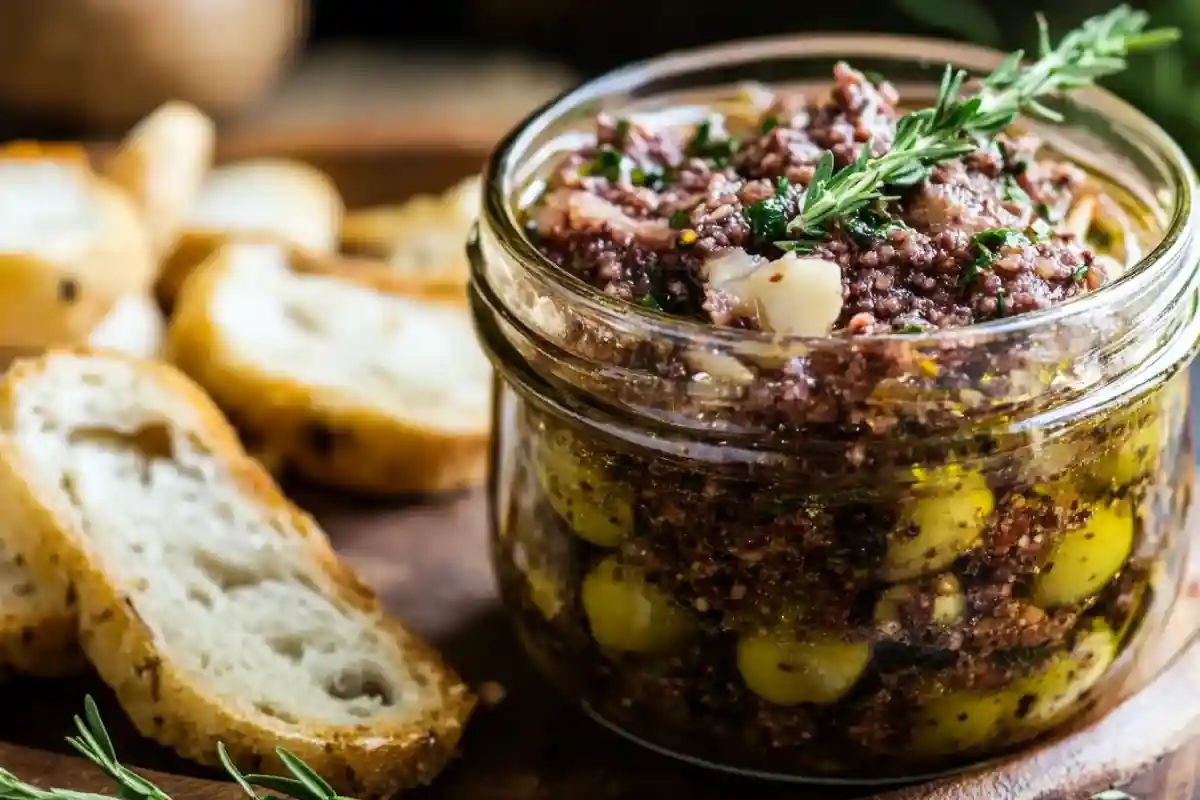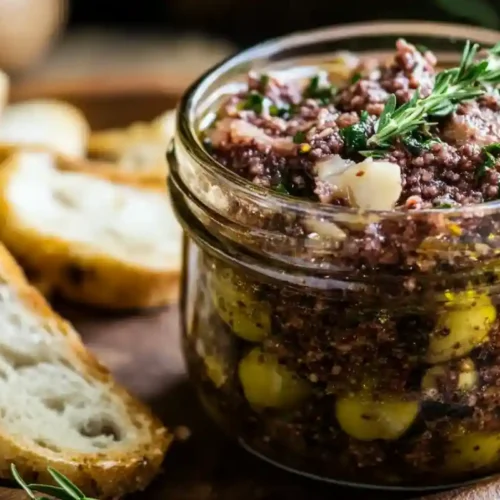
Table of Contents
A jar of Italian olive spread brings instant trattoria vibes to your table: chopped Castelvetrano and Kalamata olives folded with garlic, capers, and fruity olive oil. After three pulse-tests in the food processor I locked in a texture that stays chunky yet scoopable—perfect on crostini, sandwiches, or tossed through pasta.
What Is Italian Olive Spread?
Olives, the star ingredient, offer a wealth of health benefits. Packed with vitamin E and antioxidants, they contribute to heart health, diabetes prevention, and reduced inflammation. According to WebMD, olives contain compounds like oleocanthal, which may help protect against cognitive diseases and even reduce the risk of certain cancers. Since Italian olive spread is primarily made from olives and extra virgin olive oil, it naturally carries these benefits, making it a flavorful and healthy addition to any diet.
Best Ways to Enjoy Italian Olive Spread
There are countless ways to enjoy Italian olive spread:
- As a dip – Pair it with toasted bread, pita chips, or fresh vegetables.
- As an olive spread for sandwiches – Add it to paninis, wraps, or burgers for an instant burst of flavor.
- As a topping – Spoon it over grilled fish, roasted vegetables, or pasta.
- As part of a cheese board – Serve alongside cured meats, cheeses, and nuts.
For those who love experimenting with Mediterranean flavors, this spread is a must-have. You can even try a delicious variation like olive salad to add an extra dimension to your dishes. Whether you’re making a quick snack or a gourmet meal, this flavorful spread will elevate your cooking with authentic Italian taste.
A Rich History of Italian Olive Spread
The origins of Italian olive spread trace back to ancient Mediterranean civilizations. Olives have been cultivated for thousands of years, playing a crucial role in the diets of Greeks, Romans, and Egyptians. Over time, different regions in Italy developed their own unique versions of this flavorful spread, often influenced by the local variety of olives and available ingredients.
As trade expanded, so did the popularity of olive-based condiments. In Southern Italy, where olives grow abundantly, families traditionally prepared their own chopped olive spread using fresh herbs, garlic, and extra virgin olive oil. Some variations even included sun-dried tomatoes or capers, adding extra layers of flavor. Today, this spread remains a staple in Italian cuisine, frequently served as an appetizer or a complement to hearty meals.
Regional Variations of Italian Olive Spread
Although Italian olive spread shares common ingredients, different regions put their own spin on it. Here’s a look at how flavors vary across Italy:
| Region | Key Ingredients | Distinctive Feature |
|---|---|---|
| Sicily | Green olives, capers, anchovies, lemon zest | Tangy and briny with citrus notes |
| Tuscany | Black olives, rosemary, garlic, olive oil | Earthy and bold flavors |
| Puglia | Green olives, sun-dried tomatoes, red chili | Slightly spicy with a sweet touch |
| Liguria | Black olives, pine nuts, basil, Parmesan | Creamy with a nutty aroma |
Why Italian Olive Spread Stands the Test of Time
There are several reasons why this Mediterranean delight has remained popular for centuries:
- Timeless Flavor – The perfect combination of olives, herbs, and olive oil creates an irresistible taste.
- Cultural Significance – It has been part of Italian traditions for generations, making it a symbol of heritage.
- Versatile Uses – From an olive spread for sandwiches to a dip, it pairs well with countless dishes.
- Nutritional Benefits – Rich in healthy fats and antioxidants, it supports heart health and overall well-being.
For those who want to explore another beloved Italian-inspired dish, check out this muffuletta bread recipe, perfect for making hearty sandwiches layered with olive spread.
As we move forward, we’ll take a closer look at the essential ingredients that make Italian olive spread such a flavorful and versatile dish.
Ingredients and Variations of Italian Olive Spread
Creating an authentic Italian olive spread begins with selecting high-quality ingredients. The foundation of this spread is olives, but additional components enhance the flavor, texture, and richness. Whether you prefer a traditional recipe or want to experiment with different variations, understanding the key ingredients is essential.
Essential Ingredients for Italian Olive Spread
The classic recipe includes:
- Olives – Green or black, depending on the desired flavor profile.
- Extra virgin olive oil – Provides a smooth texture and enhances taste.
- Garlic – Adds depth and a mild pungency.
- Capers – Brings a slightly tangy and salty note.
- Lemon juice – Offers a touch of acidity for balance.
- Herbs (rosemary, oregano, or basil) – Infuses fresh Mediterranean flavors.
Popular Variations Across Italy
Different regions have put their own spin on Italian olive spread, incorporating local ingredients to create unique flavors.
| Variation | Key Ingredients | Flavor Profile |
|---|---|---|
| Sicilian Style | Green olives, capers, anchovies, lemon zest | Tangy, briny, and citrusy |
| Tuscan Blend | Black olives, rosemary, garlic, olive oil | Earthy, robust, and aromatic |
| Spicy Calabrian | Green olives, red chili flakes, sun-dried tomatoes | Spicy with a slight sweetness |
| Creamy Ligurian | Black olives, pine nuts, Parmesan cheese | Smooth, nutty, and rich |
Why Experimenting with Olive Spread is a Great Idea
Trying different variations of Italian olive spread allows you to:
- Customize flavors – Adjust ingredients to suit your taste.
- Pair with various dishes – From an olive spread for sandwiches to a pasta topping.
- Enhance texture – Keep it chunky or blend it into a smooth paste.
If you’re interested in using your spread in a gourmet sandwich, try this recipe for mini muffuletta sandwiches, which highlight the perfect balance of flavors.
How to Make Italian Olive Spread at Home
Making Italian olive spread at home is simple, quick, and rewarding. With just a few fresh ingredients and a food processor, you can create a flavorful spread that enhances any meal. Whether you prefer a chunky texture or a smooth consistency, adjusting the preparation process allows you to customize the spread to your taste.
Classic Italian Olive Spread Recipe
This traditional recipe captures the essence of Mediterranean flavors, combining briny olives, rich olive oil, and aromatic herbs for an irresistible taste.
Ingredients:
- 1 cup green or black olives (pitted)
- 2 tablespoons extra virgin olive oil
- 1 clove garlic (minced)
- 1 tablespoon capers
- 1 teaspoon fresh lemon juice
- ½ teaspoon dried oregano (or fresh basil)
- ¼ teaspoon red chili flakes (optional for spice)
Instructions:
- Prepare the Ingredients – Rinse the olives to remove excess salt and drain capers.
- Blend – In a food processor, combine all ingredients and pulse until desired consistency is reached. For a chunkier texture, pulse briefly; for a smooth paste, blend longer.
- Adjust the Flavor – Taste and add more olive oil for richness or lemon juice for acidity.
- Serve and Store – Transfer to an airtight container and refrigerate. The flavors deepen after a few hours.
Customization & Variations
While the classic recipe is delicious on its own, experimenting with additional ingredients can create exciting new flavors.
| Variation | Extra Ingredients | Flavor Profile |
|---|---|---|
| Sun-Dried Tomato | Sun-dried tomatoes, balsamic vinegar | Sweet, tangy, and deep |
| Spicy Calabrian | Red chili flakes, roasted red peppers | Spicy with a smoky undertone |
| Nutty Ligurian | Toasted pine nuts, Parmesan cheese | Creamy and nutty |
| Herb-Infused | Fresh basil, thyme, parsley | Refreshing and aromatic |
Italian Olive Spread vs. Other Olive-Based Spreads
While Italian olive spread is a favorite in Mediterranean cuisine, it is often compared to other olive-based condiments such as tapenade and muffuletta spread. Although these spreads share some ingredients, they each have unique flavors, textures, and uses. Understanding these differences can help you choose the best spread for your meals.
Key Differences Between Popular Olive Spreads
| Spread Type | Main Ingredients | Texture & Consistency | Best Uses |
|---|---|---|---|
| Italian Olive Spread | Olives, olive oil, garlic, capers, herbs | Smooth to slightly chunky | Sandwiches, pasta, appetizers |
| Tapenade | Olives, capers, anchovies, lemon juice | Smooth, paste-like | Spread for bread, dips, sauces |
| Muffuletta Spread | Olives, giardiniera, celery, vinegar, garlic | Chunky with pickled vegetables | Muffuletta sandwiches, salads |
What Makes Italian Olive Spread Unique?
Compared to other olive spreads, Italian olive spread stands out due to:
- A Balanced Flavor – Unlike tapenade, which has a briny and strong anchovy taste, Italian olive spread offers a more balanced olive and herb flavor.
- Versatility – It pairs well with everything from olive spread for sandwiches to grilled meats and pasta.
- Smoother Texture – While muffuletta spread contains chunky pickled vegetables, Italian olive spread is smoother, making it easier to spread on bread.
When to Use Each Spread
Depending on your recipe, one spread may work better than another:
- Choose Italian Olive Spread when making sandwiches, pasta dishes, or light appetizers.
- Use Tapenade for a rich, umami-packed flavor that pairs well with seafood or crackers.
- Opt for Muffuletta Spread if you want a tangy, pickled flavor for New Orleans-style sandwiches.
By understanding these differences, you can make the best choice for your culinary needs. Next, we’ll answer some frequently asked questions about Italian olive spread to help you get the most out of this delicious condiment.
FAQs About Italian Olive Spread
What is muffuletta spread made of?
Muffuletta spread is made from green and black olives, giardiniera (pickled vegetables), capers, garlic, oregano, olive oil, and vinegar. It has a chunky texture and a tangy, briny flavor, making it a key ingredient in the classic muffuletta sandwich.
What is a tapenade made of?
Tapenade is a French olive paste made with black or green olives, capers, anchovies, garlic, lemon juice, and extra virgin olive oil. It has a smooth, salty, and intensely savory flavor, often used as a dip or spread.
Is olive tapenade the same as olive spread?
No, olive tapenade and Italian olive spread are different. Tapenade contains anchovies, making it saltier and more intense, while Italian olive spread is herbaceous and balanced, often without anchovies.
Is olive spread healthier than butter?
Yes, Italian olive spread is healthier than butter because it is rich in heart-healthy fats, lower in saturated fat, and packed with antioxidants. However, it can be high in sodium, so it’s best consumed in moderation.
Conclusion
Italian olive spread is more than just a delicious condiment—it’s a versatile, flavorful, and healthy addition to any meal. Whether you use it as a dip, a sandwich spread, or a topping for pasta and grilled dishes, its rich Mediterranean flavors can elevate even the simplest recipes. Plus, with endless variations, you can easily customize it to suit your taste preferences.
Because it is made with heart-healthy olives, olive oil, and natural herbs, Italian olive spread offers numerous health benefits. It’s a great alternative to processed spreads and butter, making it a smart choice for those looking to enjoy bold flavors while maintaining a balanced diet.
Now that you know how to make, use, and pair Italian olive spread, it’s time to try it for yourself! Whether you follow a classic recipe or experiment with new ingredients, this Mediterranean favorite is sure to become a staple in your kitchen. So, grab some fresh bread, prepare a batch, and enjoy the authentic taste of Italy in every bite!

Classic Italian Olive Spread
Ingredients
- 1 cup Green or black olives Pitted rinsed, and drained
- 2 tbsp Extra virgin olive oil Adjust for consistency
- 1 clove Garlic Minced or finely chopped
- 1 tbsp Capers Drained
- 1 tsp Lemon juice Freshly squeezed
- ½ tsp Dried oregano Or use fresh herbs
- ¼ tsp Red chili flakes Optional for heat
Instructions
- Prepare Ingredients – Rinse and drain the olives and capers to remove excess salt.
- Blend the Spread – Add all ingredients to a food processor and pulse until the desired consistency is reached. For a chunkier spread, pulse briefly; for a smoother texture, blend longer.
- Adjust the Flavor – Taste and add more olive oil for richness or lemon juice for acidity.
- Serve & Store – Transfer to an airtight container and refrigerate for at least 30 minutes to let flavors develop. Enjoy with bread, crackers, or as a sandwich spread.
Notes
- For a richer flavor, let the spread sit for a few hours before serving.
- Want a different twist? Add sun-dried tomatoes, roasted peppers, or Parmesan for extra depth.
- Storage: Keep in an airtight container in the fridge for up to 5 days.
